-
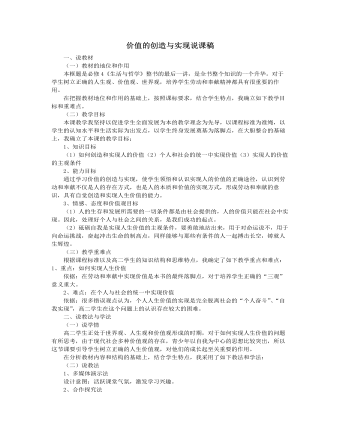
人教版高中政治必修4价值的创造与实现说课稿(一)
(六)巩固练习:习题见教学设计(七)布置作业:适量的同步练习题设计意图:反馈矫正,以便于进行教后反思。四、说教学反思新课程理念呼唤改变学生的学习方式,建立旨在调动和发挥学生主体作用的自主、合作、探究的学习方式。鼓励学生结合实际大胆对一些问题进行探究,在活动中体验和领悟,从而构建新的知识。通过探究、思辨、实践等方式,引导学生生成核心哲学观点,展示学生生活智慧,培养科学思维习惯,提升学生思维能力,形成情感、态度与价值观。本课例在设计时围绕本框的三个知识点:“在劳动和奉献中创造价值”、“在个人与社会的统一中实现价值”和“在砥砺自我中走向成功”,按照“情境导入——激发情意——自主学习,合作探究。”模式展开教学。在这样的教学中,我们收获了新课改教学经验,但是也存在着不足,日后还需继续加以改进。
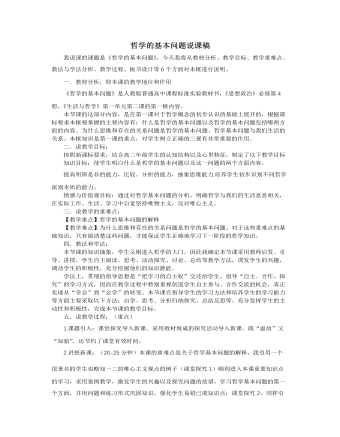
人教版高中政治必修4哲学的基本问题说课稿(一)
五.说教学过程:(重点)1.课题引入:课堂探究导入新课。采用教材现成的探究活动导入新课,既“温故”又“知新”,还节约了课堂有效时间。2.讲授新课:(20-25分钟)本课的重难点是关于哲学基本问题的解释,我引用一个很著名的学生也略知一二的唯心主义观点的例子(课堂探究1)顺利进入本课重要知识点的学习,采用案例教学,激发学生的兴趣以及探究问题的欲望,学习哲学基本问题的第一个方面,并用问题和练习形式巩固知识,强化学生易错已混知识点;课堂探究2,同样引用哲学上的著名案例让学生分析探究思考以及合作交流,学生趣味浓厚,主动深入学习本课知识,达到预期教学目的。此时,本课的重点知识教学完成。关于本课的第二个知识点“为什么思维和存在的关系问题是哲学的基本问题”采用学生自主阅读、合作交流的方法,归纳总结,完成本知识目标。3.课堂反馈、知识迁移(10-15分钟)采用学生总结、随堂练习等形式巩固本课知识,同时检验教学效果。可使学生更深刻的理解教学重点。
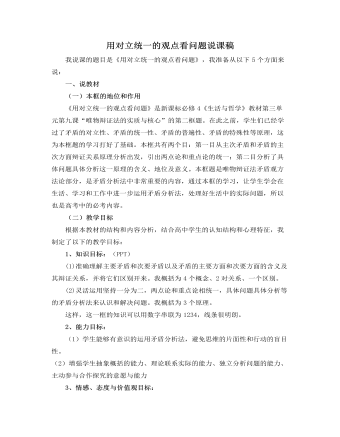
人教版高中政治必修4用对立统一的观点看问题说课稿(二)
【设计意图】通过认识自我这一环节的设计,让学生能够准确的理解矛盾的主次方面,做到能够正确的评价事物,尤其是能够正确的认识评价自己和他人,做到扬长避短,从而达到情感态度价值观目标。为了更好的区分主次矛盾与矛盾的主次方面,在此我以小组赛的形式设计了【我用我学正确识别】这一学生合作探究活动来强化对知识的掌握。(用时大约6分钟)。通过对难点主次矛盾和矛盾主次方面的深入学习,师生共同找出其共同之处:均是两点与重点,从而讲解主次矛盾和矛盾主次方面共同的方法论要求:坚持两点论与重点论的统一。3、坚持具体问题具体分析(约8分钟)由于第二目知识点具体问题具体分析内容上比较简单,因此在过渡后主要以学生自学为主,我围绕“成功”制作两个幻灯片作简单讲解与归纳。
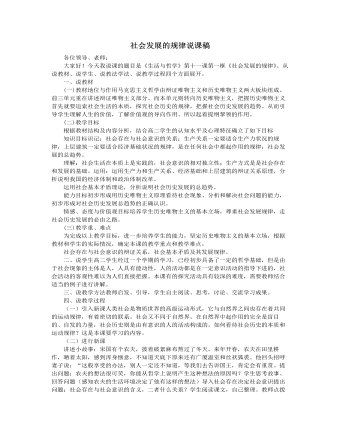
人教版高中政治必修4社会发展的规律说课稿(一)
学生回答:推动社会发展的矛盾是:生产力和生产关系的矛盾,经济基础和上层建筑的矛盾。问题:你知道人类社会存在和发展的基础吗?学生回答,步步深入。社会发展的规律是生产关系一定要适合生产力发展的规律,上层建筑一定要适合经济基础状况的规律。你是如何理解这两个规律的?请举例说明。那么你是如何理解这一规律的,请举例说明学生阅读教材第二目,并举例说明。培养学生自我学习能力。教师归纳:总结生产力和生产关系、经济基础和上层建筑的辩证关系原理。过渡:我们掌握了社会发展的规律,那么同学们来说一下,社会发展呈什么趋势?这一趋势怎么实现的?社会矛盾的解决方式有几种,为什么会有这么的区别,我们国家的矛盾解决靠什么方式来完成?学生阅读教材第三目,学生分组合作探究,交流发言。设计意图:提升推导能力,引导深化认识。教师归纳总结:社会历史发展的总趋势是前进的、上升的,发展的过程是曲折的。

人教版新课标高中物理必修1牛顿第三定律说课稿2篇
问:为什么会出现这样的情况,男女生之间的拉力存在着怎样的大小关系?进一步求证这两个力的大小关系经过共同讨论,得方案:把两个弹簧秤勾在一起,重现拔河比赛,分三种情况进行。(通过摄像头把弹簧秤的读数放大)两弹簧称勾在一起拉,处于静止不动时(即拔河比赛,双方处于僵持状态)两弹簧称勾在一起拉,并向一方运动(即比赛绳子被拉向一方时的状态)3、两弹簧称勾在一起拉,一方方向慢慢改变(两力方向始终在一条直线上)实验结论:两弹簧称的读数的变化总是相同的,大小相等,方向相反。得到牛顿第三定律:追问:既然两个力大小相等,那么拔河比赛为什么还存在胜负之分?讲清作用力与反作用力作用的受力物体不同,并和学生讨论如何做才会获胜。回应课前问题:“以卵击石”为什么鸡蛋碎?
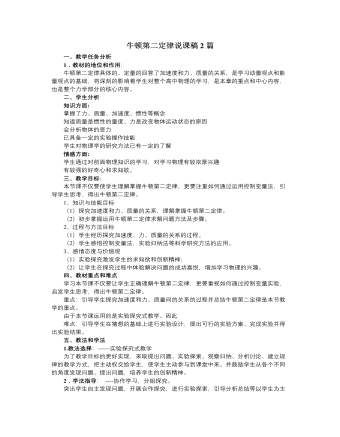
人教版新课标高中物理必修1牛顿第二定律说课稿2篇
进一步引导学生思考利用数学知识可写成等式F=kma学生很自然就会思考比列系数K应该是多少?通过教师引导学生举例各国长度单位不同(如英国:英里、码、英尺、英寸;中国:市里、市丈、市尺、市寸、市分 )导致交流不便。为了适应各国交流需要国际计量局规定了一套统一的单位,称为国际单位制 。取不同的单位制K是不同的,为了简洁方便,在选取了质量和加速度的国际单位(Kg, m/s2)时规定K=1。那么就有;F=ma为了纪念牛顿,就把能使1kg物体获得1m/s2加速度的力称做一牛顿,用符号N表示问题:实际物体受力往往不止一个,多个力情况应该怎么办呢?平行四边形法则进一步引导学生得出牛顿第二定律更一般的表达式: F合=ma思考.讨论我们用力提一个很重的箱子,却提不动它。这个力产生了加速度吗?要是产生了,箱子的运动状态却并没有改变。为什么?
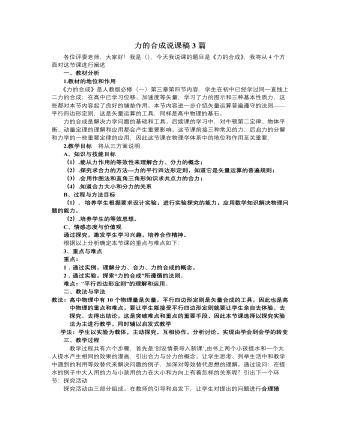
人教版新课标高中物理必修1力的合成说课稿3篇
① 实验设计将学生分组,利用桌上的器材进行探究(幻灯片展示)这个实验难度较大,为了降低难度,为实验探究铺下第二台阶,要求学生先分小组讨论以下问题(幻灯片展示)有些学生可能不知如何下手,我会要求学生先阅读课本中的实验描述从中得到一点提示,再让一两个小组同学回答,这样既体现了学生学习的主体性又可提高学生自主思考和语言表达能力,之后我再进行补充完善(幻灯片展示答案),并用幻灯片把实验步骤展示出来,在学生实验过程一直保留,使学生能朝正确的方向进行猜想和操作,为实验探究铺下第三个台阶。② 实施探究在学生分组进行探究过程,教师巡视解惑,随时观察学生情况,解答学生提出的问题,还可用自言自语方式提示应注意的一些问题,如仪器的正确使用,操作的规范等,帮助学生尽量在规定时间内顺利完成实验。
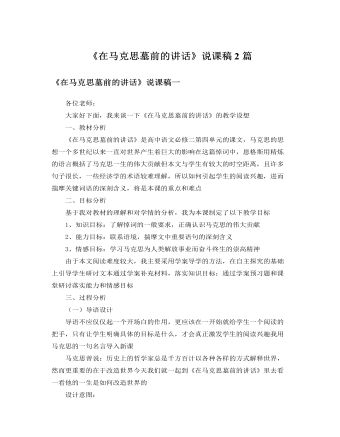
人教版高中语文必修2《在马克思墓前的讲话》说课稿2篇
(二)、课前检测:1.课文从哪几方面介绍马克思的伟大贡献?具体介绍一下有哪些伟大贡献?2.概述课文的结构。此项设置主要是让学生熟悉课文,为下文揣摩语言打基础。“温故知新”。(三)、新课讲授:1.先引导学生完成一些语句的揣摩理解,然后师生共同归纳揣摩重点语句的方法。问题1:为什么说马克思“停止思想”“安静地睡着了”“永远地睡着了”?问题2:讳饰修辞手法的运用有什么作用?答案:表达了作者对马克思的哀悼与尊敬以及不忍再说,而又不得不说的沉痛心情。以上两个问题重在引导学生从重点句段入手揣摩语言。问题3:第三段是一个复杂的单句,它的句子主干是什么?冒号后面作为宾语的复指成分可以分为哪几层意思?“正像达尔文……一样”在句子中是什么成分?起什么作用?
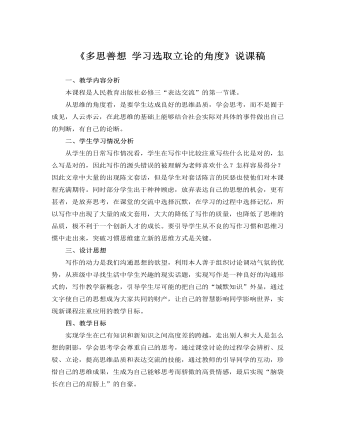
人教版高中语文必修3《多思善想 学习选取立论的角度》说课稿
谈到这,如果有人会说这仅仅是在于我个人与战场之上,战场之下另当别论,那么,他完全错了。在我小学四年级的语文课上有两个人发言积极,一个姓黄,一个姓康,黄同学发言比康同学更积极,班上的同学常以为黄同学是个了不得的人物,后来,教语文的吴老师曾悄悄地告诉我:班上真正厉害的是康x,那黄x没什么,说的全是“一点通”上的,照搬不误。说到这,我还得厚着脸皮自夸一下,在四年级时,我和康同学是同坐,一次,老师叫我们对一片课文(好象是写黄继光舍身炸暗堡)的一个段落提问题时,我悄悄地对康同学说了一个问题,康同学对我说:“你站起来说嘛。”内向的我遥遥头,康同学便站举手,并起来将我的问题大声地说了出来,结果老师说:“恩,康x的问题提得很好。”
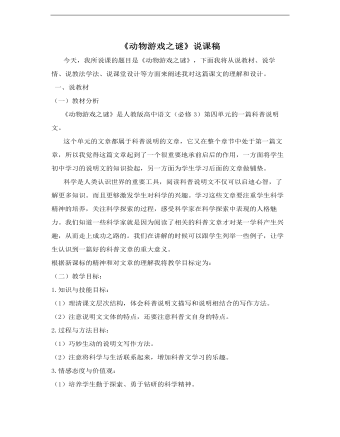
高中语文人教版必修三《动物游戏之谜》说课稿
科学是人类认识世界的重要工具,阅读科普说明文不仅可以启迪心智,了解更多知识。而且更够激发学生对科学的兴趣。学习这些文章要注重学生科学精神的培养,关注科学探索的过程,感受科学家在科学探索中表现的人格魅力。我们知道一些科学家就是因为阅读了相关的科普文章才对某一学科产生兴趣,从而走上成功之路的。我们在讲解的时候可以跟学生列举一些例子,让学生认识到一篇好的科普文章的重大意义。
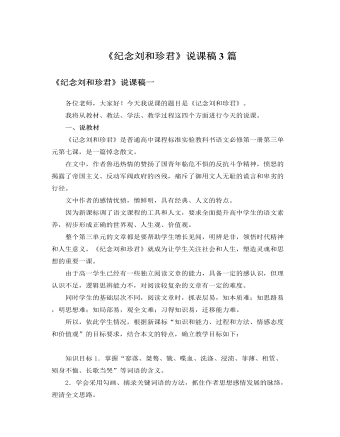
人教版高中语文必修1《纪念刘和珍君》说课稿3篇
1.说教材《记念刘和珍君》是鲁迅先生用饱醮着热泪,用悲愤的笔调写下的一篇感人至深的散文,既有对爱国青年沉痛的悼念,又有对反动派愤怒的控诉,也有对觉醒的国民的呐喊。《记念刘和珍君》是高中语文必修1第三单元第一课的讲读课文。文中描摹人物的音容笑貌,叙述人物的行为事迹,都融入了作者真挚的情感和深刻的感悟。对学生明辨是非,领悟时代精神和人生意义,有着重要的作用。新课标强调了要全面提升高中学生的语文素养,初步形成正确的世界观、人生观、价值观,并学会收集、判断、处理信息,具有人文素养、创新精神与实践能力。同时,《记念刘和珍君》感情真挚,感悟深刻,具有典型人文性。结合本单元教学目标,确立教学目标如下。
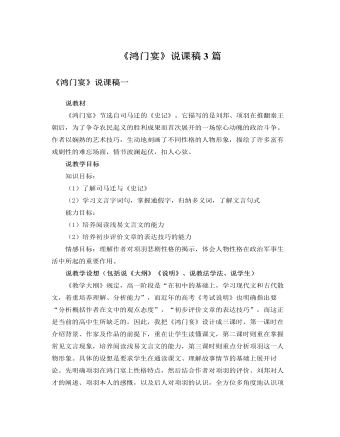
人教版高中语文必修1《鸿门宴》说课稿3篇
3、拓展延伸,启迪心智,创设课堂训练营。三、说学法1、纸上得来终觉浅,圈点、勾画、批注法,学好文言基本功。2、自主合作加探究,眼耳口脑手并用,破疑解难在其中。四、说课时安排《鸿门宴》篇幅较长,文言知识较丰富,文章内涵丰厚,因此我设计用五课时教学本文。第一课时:了解作家作品,积累文言知识,感受作者隐忍发愤的著书精神(初读)第二课时:理清故事情节,概括人物形象,学习客观地评论历史人物,(熟读)第三课时:进一步梳理文言知识,精读课文,要求读透。(精读)第四课时:通过对人物、事件的赏析,加深学生对人物的理解,锻炼学生的开放性思维,由学生自主认识到人物的性格,悲剧的原因等问题。(赏读)第五课时:补充课本教学内容:同学生一起阅读古今关于刘邦项羽的一些篇章:让学生投入进来,把握自己眼中的项羽。(展读)在文言文学习的过程中,采取五步学习法:初读-熟读-精读-赏读-展读(板书)

人教版高中语文必修1《论语》说课稿
三、文本中的句子解决完毕,大家对文本内容的理解更加深入了。请速度文本,思考:《论语》具体涉及了哪些方面的内容,体现了孔子什么观点?明确:主要有治学、从政、修身养性和交友治道等方面,体现了孔子“克己复礼”的思想。四、 教师引导学生讨论: 如何评价孔子的言行和观点?从古至今人们对孔子有哪些评价?明确:1、春秋战国时代, 孔子门人及其后学者均推尊孔子。门人中以子贡为代表,他对孔子赞美备至,奉如天人,把孔子比拟为高天、日月、木铎,凡人是永远不可企及的,认为孔子是天生的圣人,“仰之弥高,钻之弥坚”。亚圣孟子认为孔子所行的“圣人之道”是遍及自然界和社会的至高准则。然而当时民间一般看法认为孔子是博学成名的大学者。
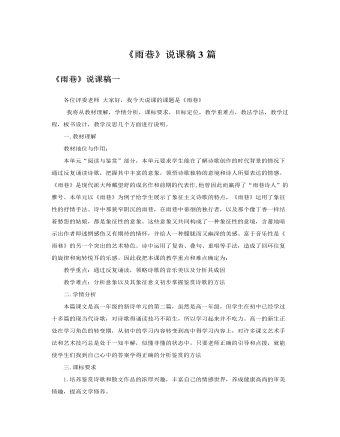
人教版高中语文必修1《雨巷》说课稿3篇
一.教材理解教材地位与作用:本单元“阅读与鉴赏”部分,本单元要求学生能在了解诗歌创作的时代背景的情况下通过反复诵读诗歌,把握其中丰富的意象,领悟诗歌独特的意境和诗人所要表达的情感。《雨巷》是现代派大师戴望舒的成名作和前期的代表作,他曾因此而赢得了“雨巷诗人”的雅号。本单元以《雨巷》为例子给学生展示了象征主义诗歌的特点,《雨巷》运用了象征性的抒情手法。诗中那狭窄阴沉的雨巷,在雨巷中徘徊的独行者,以及那个像丁香一样结着愁怨的姑娘,都是象征性的意象。这些意象又共同构成了一种象征性的意境,含蓄地暗示出作者即迷惘感伤又有期待的情怀,并给人一种朦胧而又幽深的美感。富于音乐性是《雨巷》的另一个突出的艺术特色。诗中运用了复沓、叠句、重唱等手法,造成了回环往复的旋律和宛转悦耳的乐感。因此我把本课的教学重点和难点确定为:教学重点:通过反复诵读,领略诗歌的音乐美以及分析其成因教学难点:分析意象以及其象征意义初步掌握鉴赏诗歌的方法
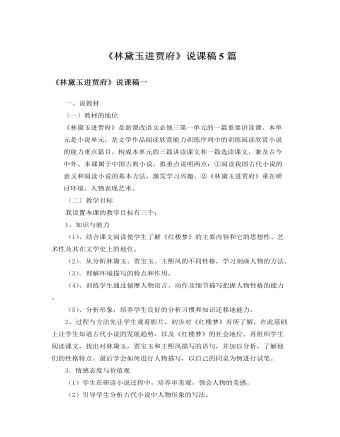
人教版高中语文必修3《林黛玉进贾府》说课稿5篇
【教学目标】我设置的本课的教学目标有三个:1、知识与技能(1)了解曹雪芹及《红楼梦》(2)学习通过一个人物的行踪、所见所闻,介绍典型环境,认识封建贵族阶级豪奢极耻的生活以及森严的等级、礼仪制度(3)分析小说人物出场的描写艺术,培养学生分析小说人物形象的能力。(4)一叶落而知秋”,通过对“林黛玉进贾府”这一故事情节的把握是否能引发对《红楼梦》的认知兴趣,并找到一个突破口,有针对性地进行自主探究,进而进行个性化解读。(5)整体认知小说,认识小说悲剧的必然性和思想价值.2、过程与方法(1)用直观演示和归纳探究法分析文章要点。(2)用讨论探究法体验作者对文中人物的情感态度。3、情感态度价值观(1)正确理解《红楼梦》的思想内涵,培养学生热爱祖国传统文化的思想感情。(2)认识封建大家族的腐朽没落,理解贾宝玉追求个性自由反封建的精神。
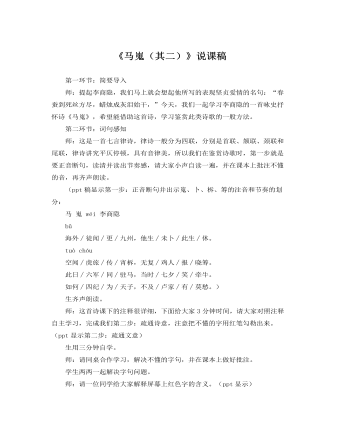
人教版高中语文必修3《马嵬(其二)》说课稿
生2:颔联的意思是只听到禁卫军中传来夜间巡逻的梆子声,不再向宫中那样安逸地听到有鸡人打鸣报时的声音了。生3:颈联的意思是说事变发生那天军队发生哗变停留不前,但当年唐玄宗以为自己可以和贵妃天天在一起,对天上的牵牛和织女一年一度的会见还加以嘲笑呢。生4:尾联的含义是为什么唐玄宗当了四十五年的皇帝,还不如普通百姓夫妻恩爱,长相厮守。师:好的。请大家再齐读一遍诗文,做到人人都能疏通诗的含义。学生再次齐读。第三环节:专项探究师:白居易曾说:“文章合为时而著,歌诗合为事而作。”这首诗就是作者途经马嵬驿,咏马嵬之变这一历史事件而作,所以我们鉴赏的第三步,就是通过标题和诗文,弄清诗中的历史事件。请同学们找出诗中哪些诗句描述了这一事件?
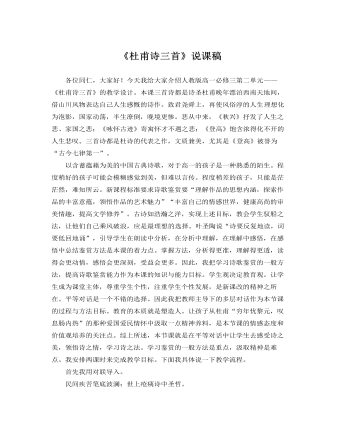
人教版高中语文必修3《杜甫诗三首》说课稿
我以以《登高》为例,引导学生进行意象分析,感悟意境美。古人云“立象以尽意”“古诗之妙,专求意象”意象是诗人情感的载体,是诗歌的灵魂。引导学生张开联想和想象的翅膀去感受,去体验是意象,诗歌鉴赏的关键。科林伍德说“真正艺术的作品,不是看见的,也不是听到的,而是想象中的某种东西。”诗人通过想象创造出诗的形象,我们读者通过想象丰富地再现诗人创造的形象。而感受体验则是以全部身心投入作品,心灵与心灵相沟通,感情与感情相交流,对诗人的想象活动进行再经历和再体验。因此,在引导意象解读中,我先让学生点击这一个,就是通过抓修饰词、依据感情基调、展开想象具体分析本诗中每个意象的情感意蕴和审美意蕴,使学生明白意象在每首诗中的独特性。
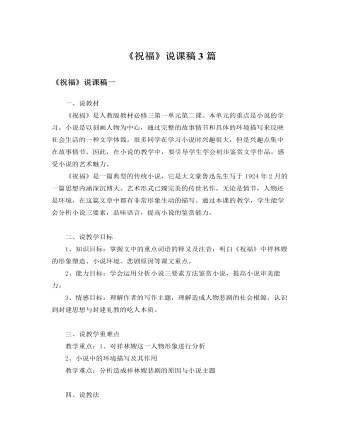
人教版高中语文必修3《祝福》说课稿3篇
各位评委老师,大家好。我说课的题目是《祝福》。一、说教材(一)教材所处的位置和地位高中语文新课程教材必修五本书,共有2个单元中外小说单元。一个必修3的第一单元,一个是必修5的第一单元,共六篇文章。(《林黛玉进贾府》《祝福》《老人与海》《林教头风雪山神庙》《装在套子里的人》《边城》)《祝福》是属于前者。小说是拥有众多读者的一种文体,它可以多方面刻画人物性格,描摹人物心理,完整地表现人物之间的冲突,还可以具体生动地再现人物生活的环境,因此在反映复杂的社会生活方面具有独特优势。所以学习小说这种文学样式,也是有助于学生学会鉴赏小说的基本方法,为将来的小说阅读打下基础。鲁迅的《祝福》是中国现代小说的精品,当中的人物祥林嫂也是鲁迅小说中与阿Q、孔乙己三个最为出名的人物之一。研读好这篇文章,对将来小说的阅读,小说中人物的理解,甚至小说的写作都有深广意义。

人教版高中英语必修1Anne's best friend说课稿
Step 7 Language points 1.Vocabulary (1) go through (2) set down (3) a series of (4) on purpose (5) in order to (6)at dusk (7)entirely (8)face to face 2.Important sentences (1)…I’ve grown so crazy about everything to do with nature. (2)There was a time when … (3)I stayed awake on purpose until … (4)It was the first time … that I’d seen the night … (5)It’s no pleasure looking through … Purpose: 1.Master the required vocabulary and sentence structures. 2.Use them freely. Step 8 Consolidation 1.Find out the topic sentences 2.Retell the text according to the topic sentences Purpose: I want to know if my students understand the text. Step 9 Discussion Imagine you have to go into hiding like Anne and her family, what would you miss most? Giveyour reasons. Purpose: Train Ss’ oral English ability. Step 10 Homework Write an article on Friends. Purpose: 1. Improve the Ss’ writing ability. 2 Train the Ss’ ability of self—teaching and looking up information by themselves. Part 5 Blackboard design(说板书设计)Unit 1 Friendship Reading Anne’s Best Friend 1.Main idea of each paragraph: Para. 1 Anne made her diary her best friend. Para .2 Anne wrote her feelings in her diary. Para .3 Anne missed nature. Para.4 Anne saw the night face to face Para.5 Anne wanted to experience nature outdoors. 2.Listening: Exx.1 P3 3.Discussion: Exx.3 P3 Purpose: 1.Make Ss familiar with the passage 2.Make the design inductive, instructive and artistic.

人教版高中英语必修3Astronomy the science of the stars说课稿3篇
Step 2 Pre-listeningAfter students finish their discussion, I will show a picture of Newton and ask them: Who is him? What is he famous for? Could you find out some words to describe him? Maybe students will answer that he is genius for his finding of theGravitation, making a great contribution to the progress of human being. At that time I will show another two pictures of Einstein and Hawking, letting students guess who they are and write down their idea about the Gravitation. For I have arranged them to search more information about the gravity before this class, Students have beenfamiliar with the topic and will not be afraid about this abstract conception, which is helpful for their listening.Step 3 While-listeningIn this step, students will be required to listen the material for three times. The first and listening is extensive listening and the second and third listening is intensive listening. In the first time, They are required to listen a material including Part 1 and Part 2 and choose the best summary of the listening text. After they choose the right answer, They also need work in group to explain what is wrong with the others. Then I will make a conclusion that we should pay attention to the first paragraph and last paragraph and some keys to get the main idea. By doing this, their capacity of generalization will have a great improvement.Before the second listening, I will ask students to scan the blank on the power point quickly and ask them to note down some key words .Then ask them to listen to the Part 1again and fill the first column of the chart. Maybe some students just show the ideas of these three scientists an still can’t catch their development of gravity. Therefore, I will ask them to listen to Part 2 again and fill in the rest. After finish the listening, I will give them ten minutes to discuss with their partner. I will also guidethem to improve their answers when they discuss with others.